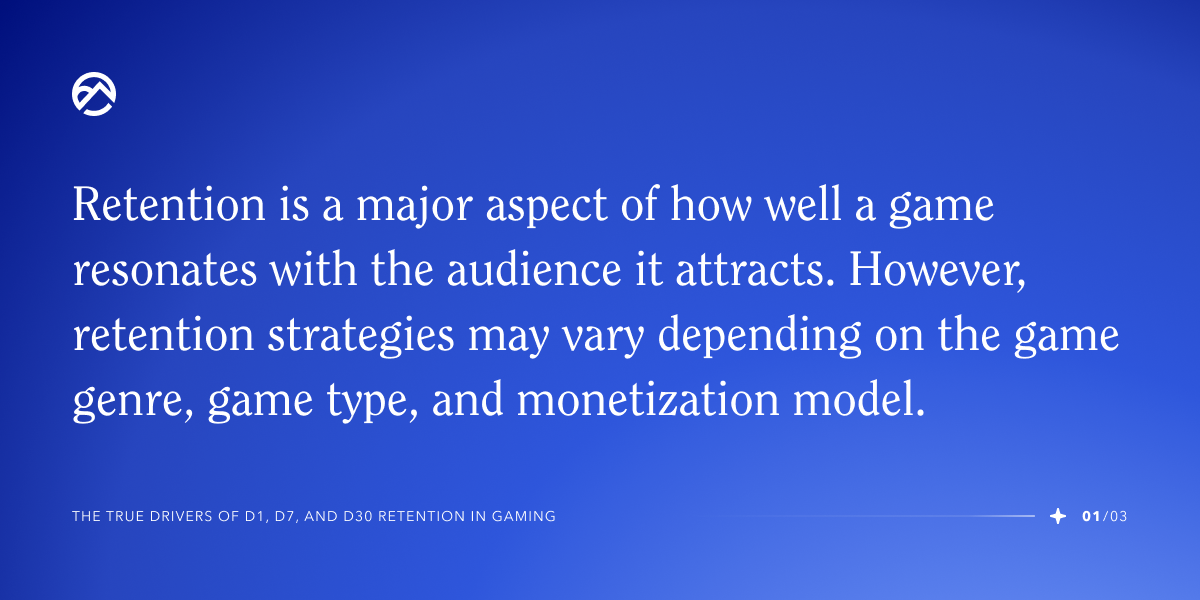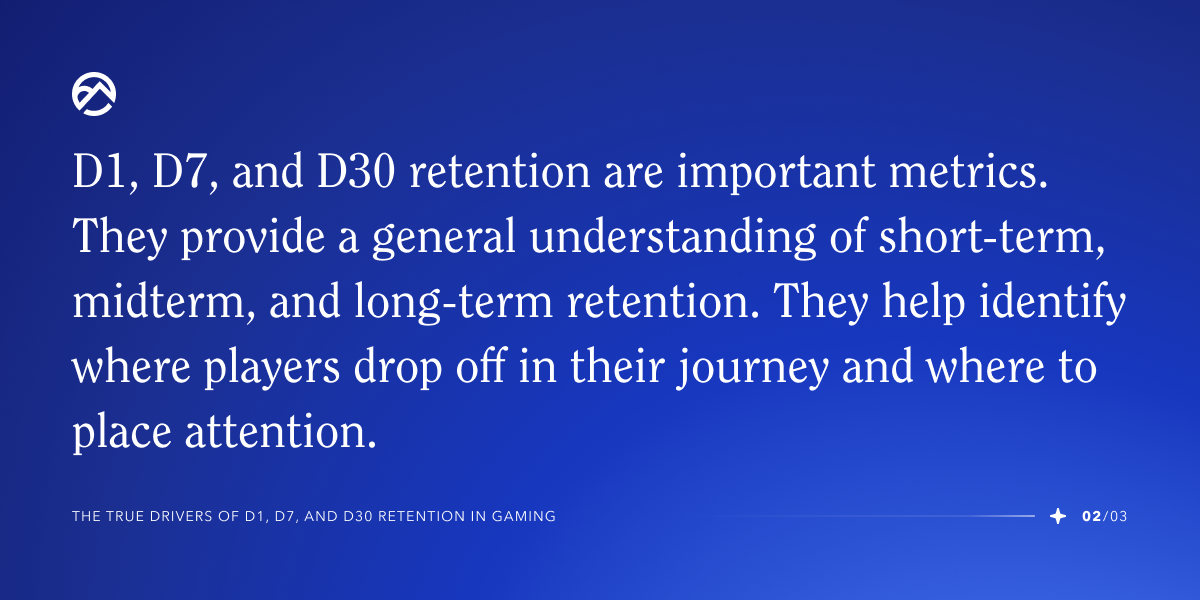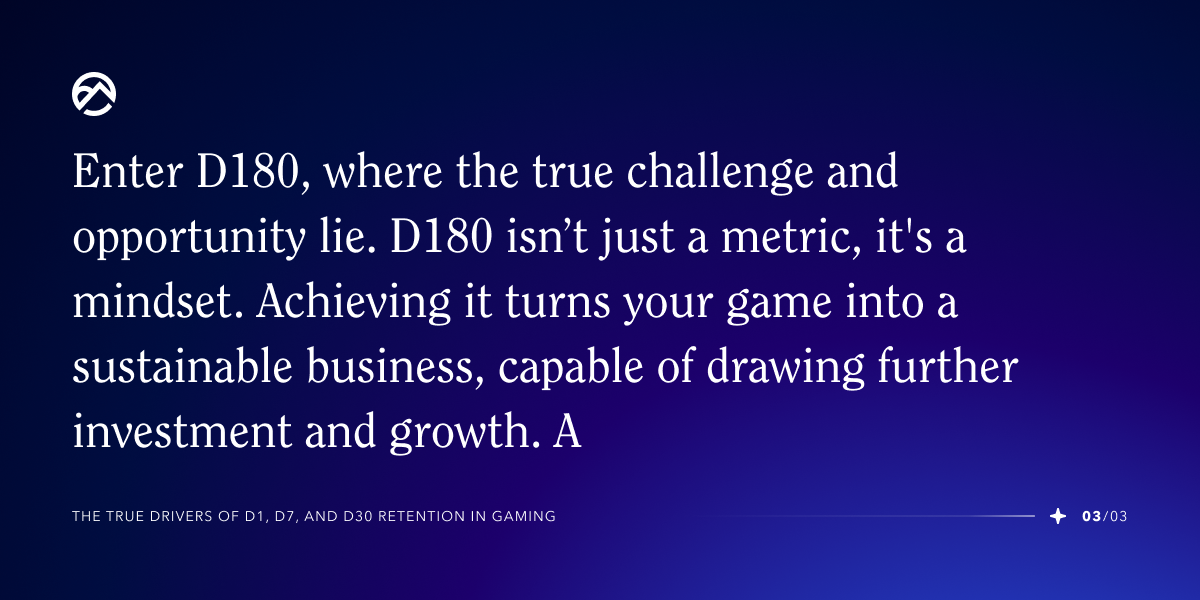The year 2022 saw the highest number of video game releases ever. To nobody’s surprise, 2023 is expected to surpass that record. In this era of intense competition for players, the most effective strategy for video game studios is to maximize the value of their existing player base. A pivotal aspect of this strategy is player retention.
In fact, increasing retention rates by just 5% can increase profits by up to 95%. Typically, people scrutinize player retention through the lenses of day 1, day 7, and day 30, commonly known as D1, D7, and D30 retention.
While these three retention milestones are critical, they are often conflated. This leads to a distorted perspective of what it takes to build a successful game. It’s imperative to recognize that these metrics are distinct and that their significance varies across different game genres and types.
In this article, we’ll dig into the nuances that set D1, D7, and D30 retention apart. We’ll explore why focusing on one over the others can be a game-changer for a specific game or genre. We’ll also uncover the driving forces behind each of these retention metrics and how they can diverge in various gaming contexts.
Understanding the Concept of Player Retention
If you’re a seasoned industry veteran looking for specific advice on how to retain users, feel free to skip this section. But if you’re new to gaming, it’s crucial to understand how the industry defines and measures retention.
Player retention relates to the strategies used to keep players engaged and committed to a game over time, extending beyond the initial download. It measures the percentage of users that remained active within a defined time period after downloading or purchasing a game.
Generally, games with high retention rates succeed while games with low retention rates fail.
What Does the Industry Consider to be Good D1, D7, D30 Retention Rates?
For years, industry benchmarks for good D1, D7, and D30 retention rates were D1: 40%, D7: 20%, and D30: 10%. But, with skyrocketing UA costs, a D1 retention rate of 50% or higher seems to be the new standard. These benchmarks can vary depending on the type of game and its target audience.

How Player Retention Can Change Across Genres and Platforms
Retention is a major aspect of how well a game resonates with the audience it attracts. However, retention strategies may vary depending on the game genre, game type, and monetization model.
For example, hyper-casual mobile games often focus on immediate user engagement and simple gameplay mechanics. They prioritize acquiring a large number of users quickly and cheaply, and generating revenue through ads.
With this model, long-term retention is not a priority. In fact, many hyper-casual games don’t value retention at all. The issue here is that these games have a much shorter expiration date. This puts stress on the overall business to create repeat hyper-casual hits.
Live service games have a different focus on retention than games that aren’t. Live-operated games frequently update content and engage players over time to keep them invested in the game. For non-live games, long-tail engagement focuses on a player’s willingness to buy the next thing, like downloadable content (DLC) and sequels.
In paid games, the focus shifts because the goal is not necessarily to optimize revenue for retention. Paid games usually have fewer updates compared to free-to-play games. They don’t need to constantly modify monetization strategies or add events to keep players engaged. However, to attract and retain high value players, the game needs to have an active user base.
For premium games, players have made an upfront investment (usually a significant one) in purchasing the game. This initial investment serves as a barrier that keeps early retention high.
In this case, retention should be looked at through the lens of the affinity with the IP, and ultimately the brand of the studio. You want players to be enthusiastic about both the game and the studio. This increases the likelihood of them purchasing future releases from the studio.

Why D1, D7, and D30 Retention Matter
D1, D7, and D30 retention are important metrics. They provide a general understanding of short-term, midterm, and long-term retention. They help identify where players drop off in their journey and where to place attention.
On D1, the focus is on the first-time user experience (FTUE). Developers track and analyze events during the tutorial to identify specific drop-off points.
By optimizing these areas, studios can achieve better retention. Aligning the marketing journey and ads with the onboarding is crucial. The FTUE truly begins the first time a player hears about your game or sees an ad.
On D7, players have progressed further into the core gameplay. They engage in mid-game content such as PvP, social features, or events. If there is a large drop-off at this point, developers often analyze days two through 14.
Day seven is a good indicator of mid-term user retention. At this point in a free to play game, there should have been a high value conversion item. This converts the player from a non-paying payer into a paying player. These items provide significant benefit to the player, often at low cost.
By day 30, players may have reached endgame content and may become bored or dissatisfied. This is when players examine the deeper aspects of the game. This includes meta layers, economy, and the social aspects of the game.
Usually somewhere in the mid D20s a game’s retention curve becomes flat. That means a game’s D30 retention usually looks a lot like its D365 retention. This makes D30 retention a key predictor of the long-term health of a game.
The Importance of D1 Retention
D1 retention gauges how well a game captures players’ immediate interest. It reflects a game’s ability to deliver a resonant experience within the first day of installing. A low D1 retention may signal issues related to fun discovery, player guidance, or the FTUE.
In reality, strong D1 retention begins before player acquisition. The more players you acquire that align with your target audience, the better your chance of strong D1 retention.
The Impact of D1 Retention on a Game’s Success
Robust D1 retention sets the foundation for a successful game. Players who have a positive experience on their first day are more likely to remain engaged for the long haul.
Developers focus on D1 retention because it sets a cap on what can happen on D7 or D30. If a game loses 80% of its players on D1, then its D7 retention is automatically below 20%. Its D30 retention is even lower than that.
What Drives D1 Retention?
D1 retention is driven by how well a game delivers moment-to-moment fun for the audience that marketing and user acquisition efforts brought into the game. On D0, players have not made any investment in playing a game. The focus should be on providing the quickest path to an experience that players will want to continue enjoying.
A few things usually cause a poor D1 retention rate:
- Game developers have failed to find the fun
- Game developers have failed to guide people to the fun
- The game design has too many blockers (like bad UX) for players to stay in the zone
- They marketed the game to the wrong people or in the wrong way
Learn How to Improve D1 Retention
The Importance of D7 Retention
D7 retention is crucial for sustaining player engagement beyond the initial excitement. This makes it a key predictor of a game’s long-term health. Strong D7 retention indicates that players have explored the game’s core mechanics and are participating in its meta-systems. This includes progression and social features.
On the other hand, high D1 retention but low D7 retention suggests a few things. Players may feel they have completed all available content in the game. The progression system may lack enough rewards. The grind may also feel too punishing.
All these factors result in a rapid turnover of players. They’re unwilling to invest more time because of the perceived limited payoff.
What Drives D7 Retention?
D7 retention is driven by players finding the game’s progression and social features rewarding. It reflects players’ engagement with a game’s deeper systems beyond the initial experience.
Learn How to Improve D7 Retention
The Importance of D30 Retention
D30 retention reflects players who have thoroughly explored a game’s mechanics and meta-systems and found that they resonate with their needs. Prioritizing D30 retention is crucial for a game’s long-term success.
Optimizing D30 retention becomes challenging as players are at many different stages in a game. At this stage, it’s crucial to understand the diverse player positions. A game must provide content and experiences that cater to their specific needs and motivations.
The Impact of D30 Retention on Long-Term Success
High D30 retention is a strong indicator of a game’s long-term success and its ability to maintain a dedicated player base.
What Drives D30 Retention?
D30 retention is driven by players’ investment in a game, both in terms of time and money. They’ve integrated the game into their routines and consider it a valuable part of their gaming experience.
By day 30, players often get stuck — even paying, high value players. Game developers can increase D30 retention in a number of ways:
- Introduce limited-time events
- Introduce events with social pressure
- Make changes that add variety and excitement to the gameplay experience
These updates should align with player motivations and values to be truly effective.
Learn How to Improve D30 Retention
D180 is the New D30
Strong D30 retention is a mark of initial success, but what happens after 30 days? What if your game could do more than entertain? What if it could be more than just a game?

Enter D180, where the true challenge and opportunity lie. D180 isn’t just a metric, it’s a mindset. Achieving it turns your game into a sustainable business, capable of drawing further investment and growth. And it all starts with understanding that people don’t just play good games — they live them.
The primary focus of every top game studio is now on ensuring the longevity of their games. The longer a game can remain active, the more it becomes a sustainable business. This provides stability in budgeting, operations, growth, and revenue. It allows the game studio to develop new games and take risks that would otherwise be challenging.
This evolution demands more than just intriguing content. It calls for forging and measuring pro-social behaviors and bounded reciprocity. We’re talking about transforming gameplay into mutual, lasting relationships.
If you don’t know your players as well as you know your best friend, it’s time to start preparing your game or studio for the future of gaming. In this future landscape, the long-term appeal of games will matter just as much to players as it does to gaming businesses themselves.
